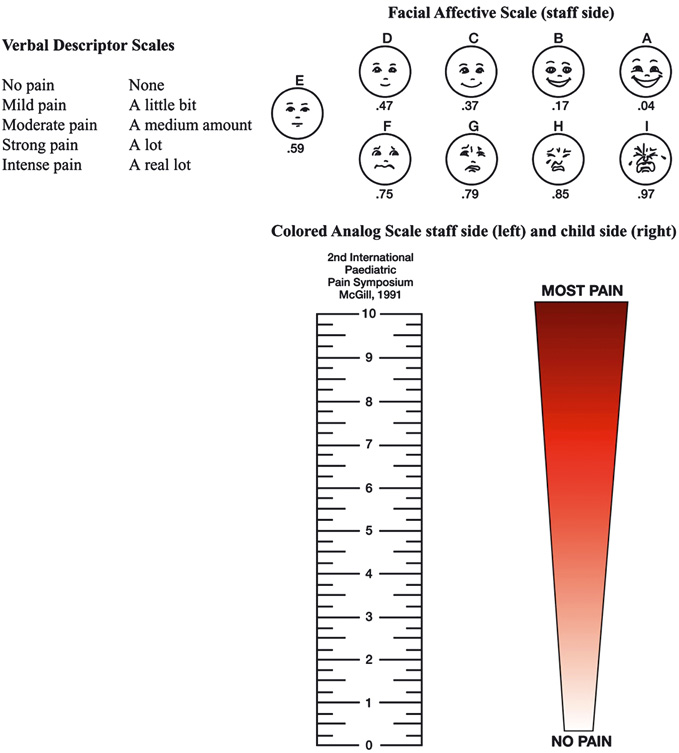Poker Chip Pain Assessment Tool
(redirected from Hester Poker Chip Tool)
Inadequate pain assessment in children may lead to an underestimation of pain, and consequently, undertreatment in this population. This article provides an overview of pain assessment and describes specific measurement tools that can be used with infants, children, and adolescents. Poker Chip Tool: assesses pain in children 4 years and up; nurse places red poker chips horizontally in front of the child, with poker chips representing 'pieces of hurt.' ; child selects how many pieces of hurt she/he has: Word-Graphic Rating Scale: assess pain in children ages 4-17 years; uses words on a horizontal linear scale to assess pain. Poker Chip Tool: assesses pain in children 4 years and up; nurse places red poker chips horizontally in front of the child, with poker chips representing 'pieces of hurt.' ; child selects how many pieces of hurt she/he has: Word-Graphic Rating Scale: assess pain in children ages 4-17 years; uses words on a horizontal linear scale to assess pain.
| Acronym | Definition |
|---|---|
| HPCT | High Performance Cartridge Tape |
| HPCT | High Performance Computing Technology |
| HPCT | High Performance Computing Toolkit (IBM) |
| HPCT | Hampshire Primary Care Trust (UK) |
| HPCT | Hematopoietic Progenitor Cell Transplant |
| HPCT | Harrow Primary Care Trust (UK) |
| HPCT | Hugh Pilkington Charitable Trust (UK) |
| HPCT | Hester Poker Chip Tool (pediatric pain assessment) |
Want to thank TFD for its existence? Tell a friend about us, add a link to this page, or visit the webmaster's page for free fun content.
Link to this page:
Behaviour ObservationalScales
CRIESis a useful tool for neonatal postoperative patients.It assesses Crying, Requirement of oxygen, Increase in vital signs, Expression,and Sleeplessness (Bildner, 1997).

FLACC is based on the observer’s assessment of the patientsFace, Legs, Activity, Cry and Consolability (Walker & Arnold, 2009).
Self-Reporting Scales
Children from 3 years of agehave the potential to reliably self-report pain using one of a number ofself-reporting pain assessment tools. These tools include the Faces pain scale– Revised, and the Wong-Baker faces pain rating scale. The Oucher scale usesphotographic images of children in differing stages of distress and a scale of0-10 alongside each picture. Younger children may find the poker chip scale usefulto quantify their pain whereas older children may be able to use the visualanalogue scale (Walker & Arnold, 2009).

Wong-Bakerfaces pain scale uses cartoon faces withdiffering expressions to indicate severity of pain from 0-10 (Walker & Arnold,2009).
The Faces pain scale has been revised from the initial sevenfaces to six with the first face representing no pain, of a 0/10 and the lastface representing 10/10. The revised faces pain scale differs from theWong-Baker faces as the ‘no pain’ face has a neutral expression instead of asmile and the most severe pain face does not have tears (Hicks, von Baeyer,Spafford, van Korlaar & Goodenough, 2001).
The Oucherscale is unique in the fact that it is availableshowing a child of a different sex and race to allow the patient to relate tothe images more easily (Beyer, Villarruel & Denyes, 2009).
Poker Chip scale uses four ‘poker chips’ as ‘pieces of hurt’which the child uses to indicate how much pain they are feeling (Kohntopp,2011).
Visual Analogue Scale consists of a line usually 10cm longwith one end representing no pain and the other end representing severe pain.The patient indicates the level of pain experienced by indicating an area onthe line (Kohntopp, 2011).